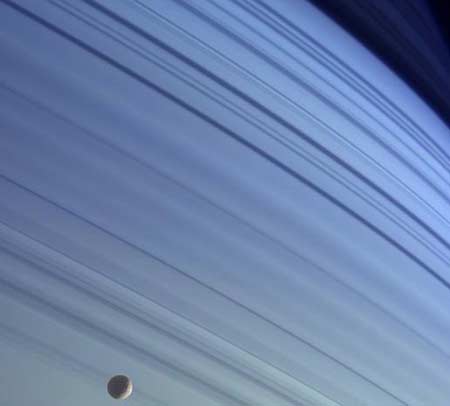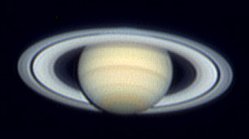|
NASA's Cassini spacecraft has discovered
another world with blue skies: Saturn.
by Dr Tony Phillips
Fast forward 100 years:
You're an astronaut piloting an airplane in the upper atmosphere
of Saturn. The gas giant has no solid surface to walk on and no
seas to put a boat in. Exploring Saturn means flying, dipping in
and out of strangely-colored clouds, racing through ring shadows.
It's a totally alien world.
It's so alien that
you start to feel homesick. So you do what they taught you in astronaut
training. Take a deep breath, look up at the sunny blue sky and
pretend to be back on Earth. Works every time!
Sunny blue skies ...
on Saturn? It's true. NASA's Cassini spacecraft discovered them
in 2005.
"We were surprised,"
recalls JPL's Bob West, a member of the Cassini imaging team. "Saturn
is supposed to be yellow."

The
blue skies of Saturn, photographed by Cassini in January
2005. In the foreground is Saturn's moon Mimas. The long,
dark lines on the atmosphere are sun-shadows cast by the
planet's rings.
|
If you've ever looked
at Saturn through a backyard telescope, you know it's true: Yellow
is the dominant color of Saturn's thick clouds.
"Sunlight reflected from those clouds is what gives Saturn
its golden hue," explains West.
But Cassini saw something
different. Close to Saturn, the spacecraft was able to photograph
the clear air above the planet's clouds. ("Air" on Saturn
is mostly hydrogen.) The color there is blue.
"Saturn's skies
are blue, we think, for the same reason Earth's skies are blue,"
says West. Molecules in the atmosphere scatter sunlight. On Earth
the molecules are oxygen (O2) and nitrogen (N2).
On Saturn the molecules are hydrogen (H2). Different
planets, different molecules, but the effect is the same: blue light
gets scattered around the sky. Other colors are scattered, too,
but not as much as blue. Physicists call this "Rayleigh
scattering."
End of story? Not quite.
"There are some
things we don't understand," says West. For example, while
Saturn's northern hemisphere has blue skies, Saturn's southern hemisphere
does not. The south looks yellow. It could be that southern
skies on Saturn are simply cloudier, yellow clouds making yellow
skies.

Saturn,
photographed by Geoff
Chester of Alexandria, VA, on Jan. 29, 2005, using
an 8-inch telescope. Saturn's blue north is hidden behind
the planet's rings.
|
The mystery, says West,
isn't why the south is cloudy--that's normal. It's why the north
is clear. "For some [unknown] reason, Saturn's northern clouds
have sunk deeper into the planet, leaving clear blue air behind."
Saturn's north is so
blue that West believes amateur astronomers could see the hue from
Earth. Unfortunately, the north of Saturn is hidden at the moment
behind Saturn's rings, a situation that will persist for another
year or so.
For now, Cassini is
in the best position to investigate. Will Saturn's blue skies fade?
Or grow to envelop the whole planet? No one knows. It is
an alien world, after all.
|
